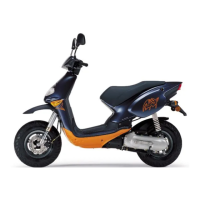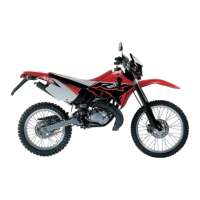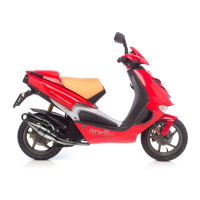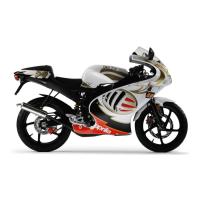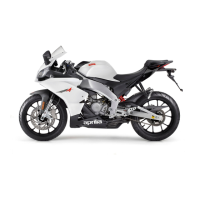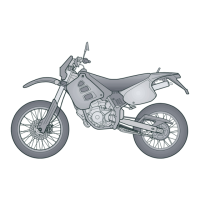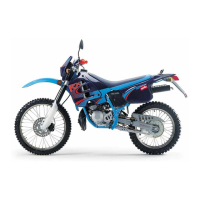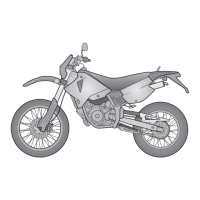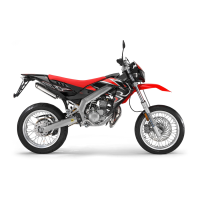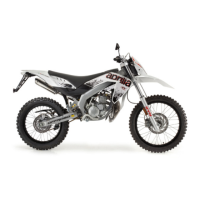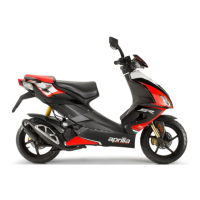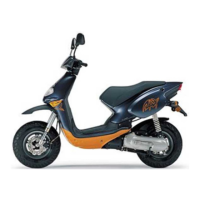
Do you have a question about the APRILIA RALLY 50 - 2003 and is the answer not in the manual?
| Fuel System | Carburetor |
|---|---|
| Cooling | Air cooled |
| Front Suspension | Telescopic fork |
| Front Brake | Disc |
| Rear Brake | Drum |
| Engine Type | Single cylinder, two-stroke |
| Rear Suspension | Monoshock |
| Bore x Stroke | 40 mm x 39.3 mm |
Defines warning symbols like 'Safety Warning', 'WARNING', 'CAUTION', and 'NOTE' used in the manual.
Covers essential safety rules regarding carbon monoxide, gasoline handling, and hot components.
Outlines the procedure for reporting vehicle defects that affect safety to NHTSA.
Details owner's duties and the warranty coverage periods for different vehicle classes.
Outlines the specific terms, limitations, and exclusions of the emission control system warranty.
Emphasizes the importance of wearing appropriate protective clothing, including helmet, gloves, and sturdy attire.
Stresses the need to meet legal requirements and receive proper rider training from a recognized organization.
Details safe riding habits, avoiding distractions, substance influence, and the importance of experience.
Emphasizes observing all road rules, warning signs, and speed limits for enhanced safety.
Advises on safe riding conduct, including avoiding risky maneuvers, maintaining distance, and interacting with other vehicles.
Explains proper braking techniques using both brakes, engine braking, and managing speed effectively.
Provides guidance on riding safely in rain, on loose surfaces, and managing traction and control.
Details the necessity of wearing well-fitting protective gear, including helmets and reflective clothing, for visibility and safety.
Details the electrical controls on both handlebars, including brake levers, throttle grip, and ignition switch.
Explains the dashboard layout, including speedometer, odometer, fuel indicator, and various warning lights.
Explains the meaning of specific warning lights, such as oil reserve, low fuel, and high beam indicators.
Details the functions of the ignition switch, including starting the engine and turning on lights.
Provides instructions on how to lock the steering to prevent theft and the key removal process.
Provides critical safety warnings and instructions for handling gasoline, avoiding spills, and preventing fires.
Explains the function of the 2-stroke oil warning light and the procedure for topping up the oil reservoir.
Emphasizes the importance of perfect brake function, warning about lever feel changes and brake disc condition.
Advises on reduced braking performance in wet conditions and the importance of checking brake lines and fluid.
Explains how to check brake fluid levels and pad wear, and the importance of clean discs.
Details the procedure for measuring and adjusting the idle stroke of the front brake lever for optimal performance.
Outlines critical steps to take after brake servicing, including lever checks and test rides in safe areas.
Explains how to check brake fluid levels in reservoirs, ensuring they are between MIN and MAX marks.
Provides instructions on how to safely top up brake fluid reservoirs, emphasizing cleanliness and correct levels.
Details procedures for checking tire inflation pressure and assessing tire wear to ensure safety.
Stresses the necessity of performing pre-ride checks to ensure vehicle safety and prevent potential accidents.
Warns about the dangers of a stuck throttle or loose fasteners, outlining immediate actions and repair requirements.
Details checks for front/rear brakes, brake levers, throttle operation, and fluid levels, ensuring proper function.
Guides on using the electric starter, including proper switch operation and warnings about exhaust gases and engine damage.
Emphasizes crucial checks before moving off, such as securing the stand, adjusting mirrors, and passenger instructions.
Details the process of starting to move, accelerating gently, and warming up the engine during the initial miles of riding.
Details optimal braking techniques, safe cornering procedures, and proper engine use for downhill riding.
Offers guidance for riding on wet, slippery surfaces, and awareness of road obstacles and traffic signals.
Lists components and the recommended service intervals for checks, cleaning, adjustments, and changes.
Guides the user through the process of removing the front wheel, including caliper and axle removal, with safety warnings.
Details the steps for reinstalling the front wheel, emphasizing correct lubrication, torque values, and caliper screw replacement.
Emphasizes critical post-service checks, including wheel centering, torque verification, and brake function tests.
Guides the user through the process of removing the rear wheel, including locking the wheel and removing the caliper.
Details the steps for reinstalling the rear wheel, emphasizing the use of a new wheel nut and correct torque values.
Provides step-by-step instructions for safely removing the rear brake caliper, emphasizing care to avoid damage.
Guides on caliper reassembly, including using new screws and performing post-service checks on the braking system.
Guides the user on visually checking the friction material thickness of brake pads and the importance of pre-trip inspections.
Explains the risks associated with excessively worn brake pads, such as reduced braking efficiency and potential damage, and advises on replacement.
Explains how to check the rear brake shoe wear indicator and the conditions for replacement.
Warns about explosive hydrogen gas, toxic electrolyte, and the importance of protective gear and correct cable connections.
